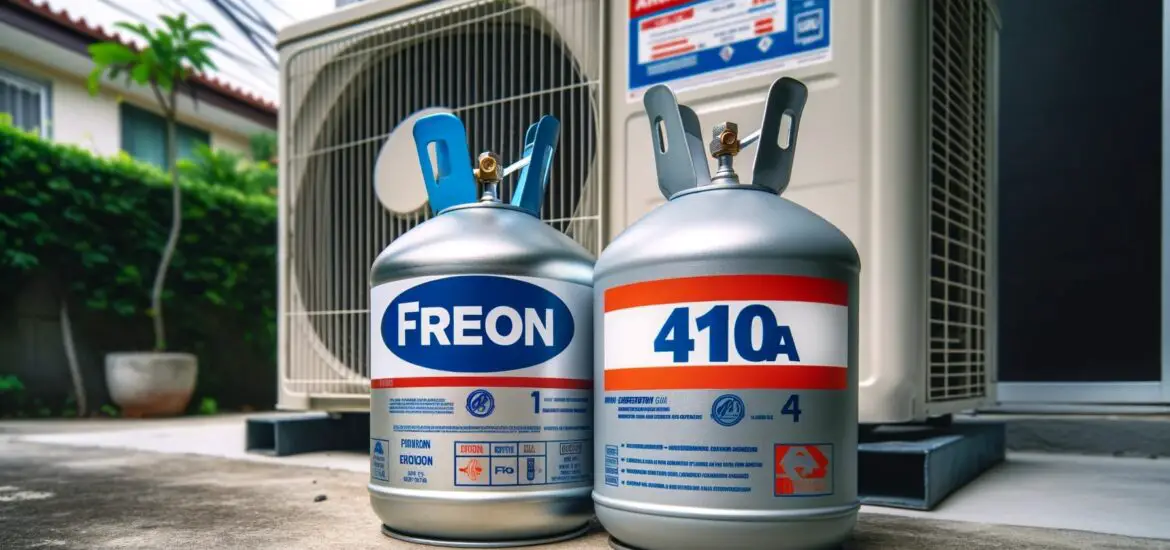This comprehensive comparison guide will reveal the differences between Freon vs 410A by exploring each aspect of these refrigerants in detail, ensuring you have a clear understanding of their implications for your cooling system.

Table of Contents
Freon vs 410A
Below, we’ll comprehensively compare Freon vs 410A refrigerant. Let’s get to it…
Chemical Composition and Environmental Impact
Freon, also known as R-22, is a chlorofluorocarbon (CFC), which means it contains chlorine, fluorine, and carbon. CFCs have been used in various applications, including air conditioning systems and refrigerators.
The presence of chlorine in CFCs like Freon is problematic. When these compounds are released into the atmosphere, the chlorine reacts with ozone molecules. This leads to the depletion of the ozone layer. This depletion increases harmful ultraviolet radiation reaching the Earth, posing health risks and environmental issues.
R-410A, known as 410A, on the other hand, is a blend of hydrofluorocarbons (HFCs), specifically difluoromethane (CH2F2) and pentafluoroethane (C2HF5). HFCs do not contain chlorine, therefore, they do not contribute to ozone depletion.
However, it’s important to note that HFCs, including 410A, are potent greenhouse gases and have a significant global warming potential. Despite this, 410A is considered more environmentally friendly compared to Freon due to its lack of ozone-depleting properties.
Energy Efficiency and Performance
The energy efficiency and performance of an air conditioning system are greatly influenced by the type of refrigerant used. 410A is known for its higher efficiency compared to Freon. This is because 410A can absorb and release more heat than Freon. Therefore, it produces better heat exchange and more effective cooling.
Consequently, air conditioners using 410A tend to have better SEER (Seasonal Energy Efficiency Ratio) ratings. This indicates higher efficiency and potentially lower energy bills.
Furthermore, 410A operates at a higher pressure than Freon. While this means that 410A systems require components that can withstand these pressures, it also allows for a more compact system design.
The higher pressure leads to a reduction in the volume of refrigerant needed. The result is smaller, more efficient, and potentially less expensive system components.
System Compatibility and Transition
Transitioning from a Freon-based system to one using 410A is not a simple task due to their differing chemical properties and operating pressures. Freon systems are not designed to handle the higher pressures of 410A.
Therefore, significant parts of the system, such as the compressor, condenser, evaporator, and refrigerant lines, need to be replaced to accommodate 410A. This transition can be a substantial investment and might not be feasible for all systems.
In addition, the lubricating oils used in Freon systems are not compatible with 410A. This incompatibility can lead to inefficient operation and potential damage to the system if not properly addressed. Complete flushing of the old system and replacement with oils compatible with 410A is necessary for a successful transition.
Cost Implications and Availability
The phase-out of Freon due to its environmental impact has led to a decrease in its production and availability, resulting in higher costs. In contrast, 410A is more readily available and generally more affordable in terms of both initial purchase and ongoing maintenance.
The higher efficiency of 410A also translates to lower operating costs over time, which can offset the initial investment in a new or upgraded system.
However, the cost of converting an existing Freon-based system to 410A can be significant. It involves not just the replacement of the refrigerant but also major system components. For some, this might mean that replacing the entire system with a new 410A-based system could be more cost-effective in the long run.
Safety Considerations
While both Freon and 410A are generally considered safe, non-toxic, and non-flammable under normal conditions, there are safety considerations to be aware of. The high operating pressure of 410A systems necessitates careful handling and installation by qualified professionals. This is done to avoid leaks and pressure-related accidents.
Regular maintenance checks are also more critical for 410A systems to ensure they operate safely and efficiently. In the event of a refrigerant leak, both Freon and 410A can displace oxygen, particularly in poorly ventilated areas, creating a risk of suffocation. Therefore, it’s crucial to ensure proper ventilation and to follow safety protocols during installation, maintenance, or in the event of a leak.
Conclusion: Making an Informed Decision
In choosing between Freon vs 410A, it’s important to consider factors such as environmental impact, energy efficiency, system compatibility, cost implications, and safety. While 410A is the more environmentally friendly and efficient option, transitioning from a Freon-based system to 410A involves significant considerations, including compatibility and cost.
For new installations, 410A is typically the recommended choice. However, for existing systems, a thorough evaluation of the benefits and costs of upgrading or replacing the system is necessary. Ultimately, consulting with HVAC professionals will provide tailored advice for your specific situation, ensuring a decision that best meets your cooling needs and environmental considerations.